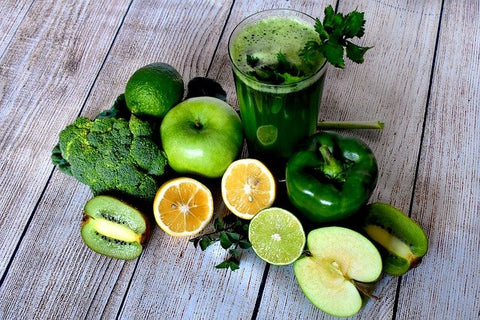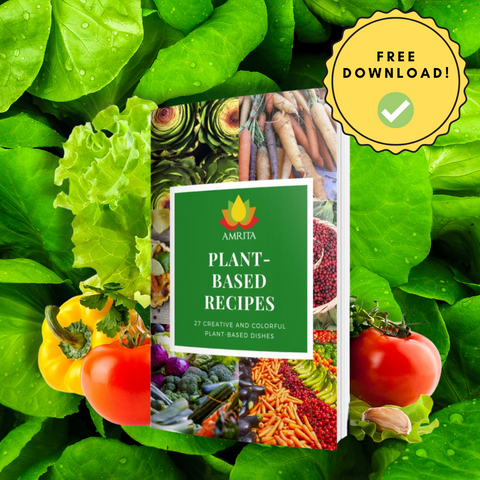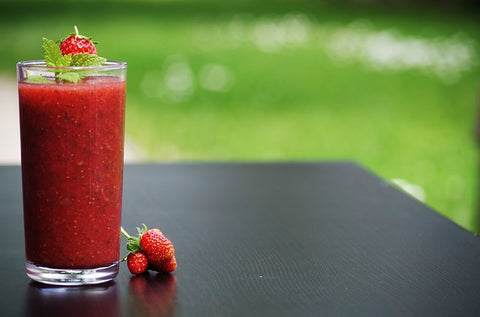For many health enthusiasts, vegan and paleo seemingly don’t mix – one is based entirely on the power of plants. At the same time, the other is stirred by the diets of our hunter-gatherer ancestors, including meat. But, regardless of the difference, we believe that these can be effectively combined.
So, if you ask whether the paleo diet can be for vegans, vegetarians, and plant-based, too, the answer is yes. As long as you maintain an adaptable and playful attitude towards your food, the possibility of integrating elements from both diets is feasible.

In this article, we’ll understand the paleo diet along with a few more things:
- What paleo diet is
- Is paleo possible for vegans, vegetarians, and plant-based
- The differences between vegan, vegetarian, plant-based, and paleo
- Paleo VS. Vegan VS. Plant-based – Which is Better?
- What Is Vegan Paleo?
- Can you be a Vegan Paleo?
- Paleo-Vegetarian diet tips and recipes
What Is Paleo Diet?
A paleo diet calls to skip grains (both refined and whole), legumes, packaged snacks, dairy, and sugar in favor of vegetables, fruit, meat, seafood, eggs, nuts, seeds, fats, and oils. It is a dietary plan based on foods similar to what was available in the stone age.
It includes natural and unprocessed foods, fresh vegetables and fruits, nuts and seeds, and healthy fats. Emulating this food concept with the foods available nowadays while increasing focus on high food quality and sustainability is the heart of the paleo diet.
However, it doesn’t mean that we are giving up our hard-earned standard of living just because we adapt to the paleolithic diet. This lifestyle is about taking the proven nutritional approaches, understanding what is good for our body, and integrating the paleo idea with the knowledge of modern science.
Paleo diet was easy for cave dwellers back in the paleolithic days as they were not tempted with thousands of processed foods we have access to now. This is where the challenge comes in for present-day humans since the only hunting we do is good deals at the supermarket.
Good deals meaning bread, cheese, yogurt, rice, candy bars, milk, chips, cereal, and so on, go in the cart.
But, the more you understand and adapt to it, the more you will realize that it is more than a diet. It is a lifestyle fitting for anyone wanting a healthier change.

Is Paleo Possible For Vegans, Vegetarians, And Plant-based?
If you wonder whether vegans, vegetarians, and plant-based can follow a paleo eating plan, the answer is simple – it is possible. However, with the pegan diet or plant-based paleo, you have to examine your health goals first.
Vegan, vegetarian, and plant-based diets are at odds with paleo – the previous advocates for eliminating dairy, meat, and fish, while the latter encourages eating meat and fish. Nonetheless, the root of these lifestyles ultimately lies in the same thing – eating whole foods and plants.
The Differences Between Vegan, Vegetarian, Plant-based, and Paleo Diets
Vegan Diet
Veganism is a lifestyle that tries to exclude all forms of animal abuse and cruelty, whether for food, clothing, or any other purpose. Thus, the vegan diet is empty of all animal products, including meat, eggs, and dairy.
The vegan diet has different types, but the most common are:
- Whole-food vegan diet – a diet based on a broad range of whole plant foods like fruits, vegetables, whole grains, legumes, nuts, and seeds.
- Raw-food vegan diet – a type of vegan diet based on raw fruits, vegetables, nuts, seeds, or plant foods cooked at temperatures below 118°F (48°C).
- 80/10/10 – this diet is a raw-food vegan diet that controls fat-rich plants like nuts and avocados and banks on raw fruits and soft greens instead. It is also referred to as the low-fat, raw-food vegan diet or fruitarian diet.
- Starch solution – a low-fat, high-carb vegan diet akin to the 80/10/10 diet. Only, this focuses on cooked starches such as potatoes, rice, and corn rather than fruit.
- Raw till 4 – another low-fat vegan diet under the likeness of 80/10/10 diet and starch solution. With this diet, raw foods are consumed until 4 p.m. with a cooked plant-based meal option for dinner.

Vegetarian Diet
The vegetarian diet implies complete abstinence from meat, fish, and poultry. The most common reason for adapting to a vegetarian lifestyle is almost like the vegan’s, mainly for religious or personal reasons and ethical issues like protecting animal rights.
A percentage of vegetarians became such for environmental reasons. Recently, a study has been published about the increase of greenhouse gas emissions from livestock production and its contribution to climate change and excessive water consumption.
Vegetarianism comes in different forms, each with its restrictions. The most common types are:
- Lacto-ovo-vegetarian diet – removes meat, fish, and poultry but allows eggs and dairy products.
- Lacto-vegetarian diet – removes meat, fish, poultry, and eggs but allows dairy products.
- Ovo-vegetarian diet – removes the meat, fish, poultry, and dairy products but allows eggs.
- Pescetarian diet – removes meat and poultry but allows fish and few amounts of eggs and dairy products.
- Vegan diet – removes the meat, fish, poultry, eggs, dairy products, and other animal-derived products like honey.
- Flexitarian diet – mainly adapts to vegetarian but incorporates occasional meat, fish, or poultry.
Plant-based Diet
A plant-based diet involves eating patterns focusing on foods primarily from plants. It includes fruits and vegetables and nuts, seeds, oils, whole grains, legumes, and beans.

To put it simply, a vegan diet excludes all meat and animal products (meat, poultry, fish, seafood, dairy, and eggs); a vegetarian diet removes the meat, poultry, fish, and seafood. In contrast, a plant-based diet may choose to eat meat and animal products for different reasons.
The paleo diet adheres to food available only during the paleolithic times. These foods include vegetables, fruits, and meat and exclude dairy, grains, processed sugar, and food presented after the invention of agriculture.
Paleo VS. Vegan VS. Plant-based – Which is Better?
These diets follow entirely different concepts and downright contradict each other. Thus, there is no general answer for it. Everyone has a decision for themselves with anything that they can find advantageous or disadvantageous for them.
The best question to ask is – is your current diet healthy?
If you are 100% sure it is, then good for you. But, if you are uncertain, then that means no. From there, you can decide which of the diets we’ve mentioned above can work suitably with your nutritional needs. It is crucial that you adapt to a diet appropriate to your personal and health conditions.

What Is Vegan Paleo?
Vegan paleo or pegan is a result of combining the vegan and paleo diets. Strictly speaking, though, vegan paleo is not 100% paleo, but it doesn’t mean it is not a working diet.
See, a vegan diet does not contain animal or dairy products. It relies solely on plant-based foods. On the other hand, the paleo diet includes meat, fish, and eggs while leaving out grains and legumes. This contradiction raises the problem.
But, as with a lot of things, something has to give. If you are not strictly vegan, pegan diet may work for you. Fundamentally, pegan is the same as paleo. Only it deals with fewer animal products. While it has a similar focus on fruits and vegetables, it also includes certain grains to widen its nutritional value.

Can You Be Pegan?
If you first assumed that going paleo and vegan at the same time sounds impossible, you are among a significant percentage of health enthusiasts still confused.
In spite of its name, the pegan diet is a unique kind of diet with its own set of guidelines. In reality, it is less restrictive than either paleo or vegan. The pegan diet emphasizes vegetables and fruits. But, intake of slight to moderate amounts of meat, certain fish, nuts, seeds, and some legumes is allowed.
If you think a more sustainable diet that you can follow indefinitely is what you need, rather than the typical and short-term ones, then the pegan diet is what you should practice.
When you do, make sure that you watch out for greens with a high glycemic index, as it can lead to a spike in your blood sugar level. Pick those with the least glycemic index possible. With the proper planning and discipline, combining both diets – becoming pegan can be successfully implemented.
What Can You Consume on Vegan Paleo Diet
Leafy greens and non-starchy vegetables
- Broccoli
- Kale
- Peppers
- Onions
- Carrots
- Tomatoes
Starchy vegetables and fruits:
- Potatoes
- Sweet potatoes
- Yams
- Turnips
- Apples
- Bananas
- Oranges
- Pears
- Avocados
- Strawberries
- Blueberries
Protein sources:
- Almonds
- Macadamia nuts
- Walnuts
- Hazelnuts
- Sunflower seeds
- Pumpkin seeds
Fat:
- Olive oil
- Coconut oil
- Avocado oil
- Almond oil
 Start your paleo-vegan transition with this FREE plant based diet recipe book.
Start your paleo-vegan transition with this FREE plant based diet recipe book.

Sample Vegan Paleo Diet
For breakfast: Sweet Potato Breakfast Bowl

What You Will Need:
- 300 g sweet potato
- 50 ml of vegetable milk or water, possibly more
- 1 tbsp date syrup
- 1/2 tsp cinnamon more or less to taste
Optional toppings:
- 1 tbsp almond butter
- 1/2 banana
- 1/2 peach
- 1 tbsp blueberries
Procedure:
- Halve the sweet potatoes and cook in the oven for about 30 minutes until tender. Turn at about half the cooking time.
- Allow the sweet potatoes to cool briefly, then remove from the bowl.
- Place in a bowl and crush with a fork. Gradually add a little liquid until the desired consistency is achieved—season with cinnamon and date syrup.
- Serve with toppings of your choice. Better served when cold.
For lunch: Roasted Brussels Sprouts with Pomegranate and Chili-Lime Sauce

Roasted Brussel Sprouts (image credit)
What You Will Need:
- 700 g Brussels sprouts
- 1 pomegranate
- 1-2 apples
- 1 lime
- 2 tbsp olive oil
- 2 tbsp date syrup
- 2 tsp chili powder
- Salt and pepper to taste
Procedure:
- Preheat the oven to 220°C.
- Wash the Brussels sprouts, cut into halves
- Place in a large bowl and mix with the chili powder, salt, pepper, and olive oil.
- Spread on a baking sheet lined with baking paper and put in the oven for 20 minutes. Turn the Brussels sprouts after 10 minutes to brown the other side.
- Wash the lime and zest. Squeeze the juice and combine it with the zest and date syrup in a bowl. Mix well.
- Take the roasted Brussels sprouts out of the oven. Mix well with the chili-lime sauce.
- Serve and enjoy!
For snack: Strawberry and Beetroot Detox Smoothie

What You Will Need:
- 200 g frozen strawberries
- 200 ml apple juice, naturally cloudy
- 50 g beetroot, fresh
- ½ frozen bananas
Optional toppings
- Fresh mint
- Toasted coconut chips
- Diced apple pieces
Procedure:
- Peel the beetroot. Add it together with the frozen bananas, apple juice, and frozen strawberries in a blender. Mix until you have a silky and creamy consistency.
- If you like more sweetness, add a little more banana or date syrup, or if too thick, add more apple juice.
- Garnish with mint, coconut chips, apple pieces, or berries!
For appetizer: Fresh Vegetable Salad with Oyster Mushrooms

What You Will Need:
- 250 g oyster mushrooms
- 130 g Romaine lettuce
- 100 g red cabbage
- 150 g zucchini
- 150 g of carrots
- 100 g cherry tomatoes
- 1 avocado
- 1 tbsp vegetable oil for frying
- 1 tbsp gluten-free soy sauce
- 50 ml water
- Salt and pepper to taste
- Paprika powder
- Cayenne pepper
For dressing:
- 4 tsp sunflower seed butter
- 2 tsp light miso paste
- 1 tablespoon of oil
- 60 ml of warm water; makes resolving easier
- Salt and pepper
Procedure:
- Tear the oyster mushrooms from the cap. Slice into fine strips and fry them in a pan with one tablespoon of oil for 10 min over medium heat.
- Season with salt, pepper, paprika powder, and cayenne pepper. Deglaze with water and soy sauce.
- Cook with the lid on for a further 10 minutes over low heat.
- In the meantime, finely chop zucchini and carrots. Cut the red cabbage and lettuce into fine strips.
- Dice the avocado and cut the tomatoes in halves.
- Place all dressing ingredients in a sealable container and shake until everything is mixed well.
- In a bowl, toss vegetables and dressing together. Place the cooked oyster mushrooms on top and serve.
For dinner: Cauliflower and Sweet Potato Curry

What You Will Need:
- 500 g cauliflower, cut into florets
- 400 g canned tomatoes
- 350 g sweet potatoes, diced
- 120 g sunflower seeds
- 2 red onions, finely chopped
- 2 limes, quartered
- 1 ginger, approximately 2 cm, finely chopped
- 2-3 garlic cloves, finely chopped
- 3 tbsp coconut oil
- 1 tsp coriander powder
- 1 tbsp tomato paste
- ½ turmeric
- ½ fresh coriander green, roughly chopped
- ½ red chili
- Salt
Optional:
- 150 g chickpeas, soaked overnight
Procedure:
- Roast the sunflower seeds in a pan without oil. Stir continuously until it turns golden brown.
- In a saucepan, heat two tablespoons of coconut oil. Saute sweet potatoes over medium heat for 5 minutes.
- Add cauliflower and saute for another 5 minutes. Stir regularly, and then remove the vegetables from the saucepan. Set aside.
- Heat remaining coconut oil in the saucepan, sauté the ginger, onion, and garlic over medium-high heat. Stir regularly for 2 minutes.
- Add spices, saute for another 30 seconds. Add tomatoes and tomato paste.
- Season with salt to taste.
- Add the sweet potato pieces, cauliflower florets, and 75 ml of water and simmer for 10 minutes with the lid closed.
- Add 2/3 of the chopped coriander to the pot.
- Optional: Put soaked chickpeas in the pot overnight. - Let everything simmer for another 3-5 minutes without a lid.
- Serve the cauliflower and sweet potato curry with basmati rice.
- Serve with sunflower seeds, onion slices, chili, and the rest of the chopped coriander leaves and lime wedges.
For dessert: Pegan Chocolate

What You Will Need:
- 250 ml coconut oil
- 250 ml date syrup
- 250 g coconut chips
- 250 g sunflower or pumpkin seeds
- 125 g cocoa powder (sugar-free)
- 1 pinch of sea salt
Procedure:
- In a food processor, combine all ingredients except the seeds. Mix until it has a nice, uniform color and consistency.
- Add the seeds. You can add small fruits, but leave them whole. Mix well.
- In a baking dish, form 1-2 cm thick bars. Or you can use molders of different shapes.
- Place in the freezer until firm.
Conclusion
The global pandemic that is COVID-19 brought more and more people into eating less meat or completely giving it up. The reasons do not merely rely on how sustainable this diet is but its positive impact on the environment and how it is beneficial for the body.
Taking a healthy path with simple and delicious plant-based dishes allows everyone to make a small contribution to the environment. Going pegan is not about utterly preceding animal products but rather finding your balance and trying not to do too much at the same time.
Everyone can manage to eat healthily. It doesn’t have to happen overnight, especially that it usually doesn’t work that way.
Remember to take small steps and start slowly. It can be as simple as replacing your heavy breakfast of bacon and eggs with porridge or chia pudding.

 For more plant based recipes, download this FREE plant-based diet recipe book.
For more plant based recipes, download this FREE plant-based diet recipe book.

We hope that through this article we were able to inspire you to take a step towards improving your health and the environment.
What diet are you currently on? How is it working for you?
Which diet are you willing to try or have second thoughts about?
What food can you easily give up? And what food can you never give up?
Share your thoughts about plant based paleo, paleo and plant based in the comments below!
Related Articles:
Beginner's Guide to Plant-based Keto Diet in 2020
Going Gluten Free Guide: 5 Things You Should Do to Simplify Transition
Mediterranean, Keto, Paleo, IF, DASH: What to try?
Minimalist Diet: How Simplifying Food Saves You Time & Money

